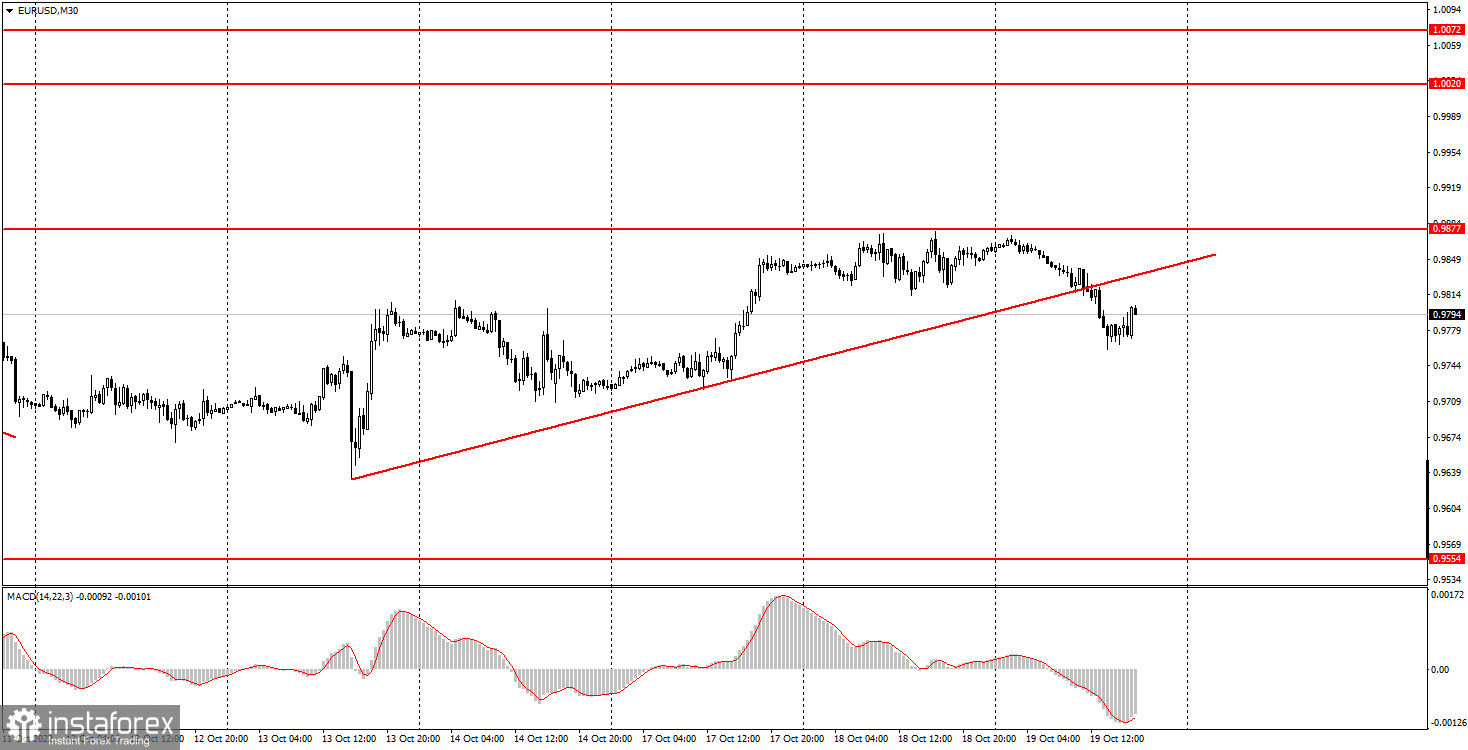Analyzing trades on Wednesday:
EUR/USD on M30 chart

EUR/USD started a new cycle of the downward movement on Wednesday and broke through the ascending trendline very quickly. This is another indication of the gloomy prospect for the euro. The pair failed to hold even above the short-term trendline. Now the pair may fall towards the target of 0.9554 which is the 20-year low. On Wednesday, the only major EU report on inflation revealed that consumer prices rose to 9.9% in September. For your reference, the forecast was 10.0%. So, the actual reading turned out to be better than expected. Yet, inflation rose considerably from 9.1% in August. As it continues to accelerate, the ECB will have to raise rates further. Market participants are sure that the regulator will hike the rate at its next meeting. However, if the rate is raised by less than 0.75%, this can be perceived as a negative sign. Investors already doubt that the ECB will be tightening monetary policy as long as required. If the rate increase at the November meeting will be less than in September, markers will be fully disappointed. The euro might have risen on Wednesday but failed to do so. Chances are high that the pair will extend its decline.
EUR/USD on M5 chart

For the most part of the day, the pair was trading with the trend on the 5-minute chart. It started to decline in the Asian session and continued the downtrend through the European trade. There was no strong reaction to the inflation report in the EU although there were some changes. The first sell signal was formed near 0.9845. Later, the price slid to 0.9807 and broke through it. On Wednesday evening, the pair was still trading below the level of 0.9807. So, this short position should have been closed manually as there was no buy signal after that. The profit from this trade was 35-40 pips which is actually good. The daily volatility range was more than 100 pips. This means that traders stay active.
Trading tips on Thursday
On the 30-minute chart, the pair gave up very quickly on the attempts to continue the upside movement. The price has settled below the trendline, so the downtrend seems more likely now. There are not so many important events this week but the market is not trading flat as it did a week earlier. On the 5-minute chart on Thursday, it is recommended to trade at 0.9636, 0.9709, 0.9807, 0.9845, 0.9877, 0.9952, and 1.0020. As soon as the price moves by 15 pips in the right direction, set the Stop Loss at breakeven. On Thursday, no key reports are expected in the EU. The US will publish only a minor report on initial jobless claims. So, there may be no drivers for the market on Thursday. Yet, the euro/dollar pair may continue to move within the trend despite low volatility.
Basic rules of the trading system
1) The strength of the signal is determined by the time it took the signal to form (a rebound or a breakout of the level). The quicker it is formed, the stronger the signal is.
2) If two or more positions were opened near a certain level based on a false signal (which did not trigger a Take Profit or test the nearest target level), then all subsequent signals at this level should be ignored.
3) When trading flat, a pair can form multiple false signals or not form them at all. In any case, it is better to stop trading at the first sign of a flat movement.
4) Trades should be opened in the period between the start of the European session and the middle of the US trading hours when all positions must be closed manually.
5) You can trade using signals from the MACD indicator on the 30-minute time frame only amid strong volatility and a clear trend that should be confirmed by a trendline or a trend channel.
6) If two levels are located too close to each other (from 5 to 15 pips), they should be considered support and resistance levels.
On the chart
Support and Resistance levels are the levels that serve as targets when buying or selling the pair. You can place Take Profit near these levels.
Red lines are channels or trend lines that display the current trend and show in which direction it is better to trade now.
The MACD indicator (14, 22, and 3) consists of a histogram and a signal line. When they cross, this is a signal to enter the market. It is recommended to use this indicator in combination with trend patterns (channels and trendlines).
Important announcements and economic reports that can be found on the economic calendar can seriously influence the trajectory of a currency pair. Therefore, at the time of their release, we recommend trading as carefully as possible or exiting the market in order to avoid sharp price fluctuations.
Beginners on Forex should remember that not every single trade has to be profitable. The development of a clear strategy and money management is the key to success in trading over a long period of time.
 English
English 
 Русский
Русский Bahasa Indonesia
Bahasa Indonesia Bahasa Malay
Bahasa Malay ไทย
ไทย Español
Español Deutsch
Deutsch Български
Български Français
Français Tiếng Việt
Tiếng Việt 中文
中文 বাংলা
বাংলা हिन्दी
हिन्दी Čeština
Čeština Українська
Українська Română
Română

